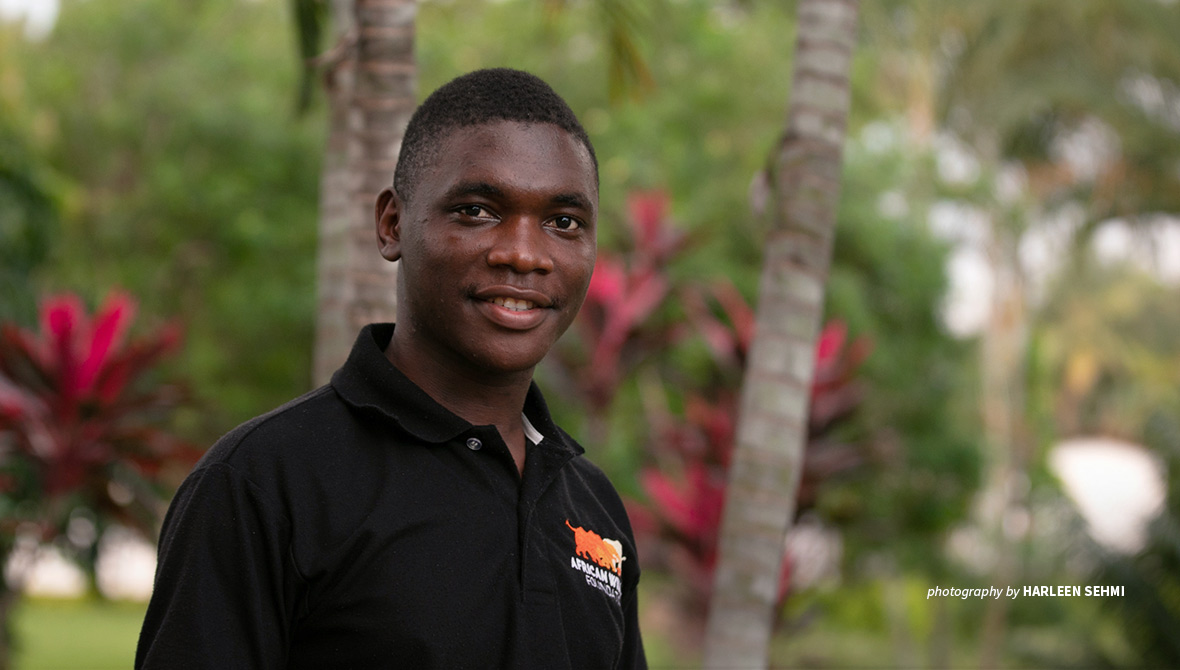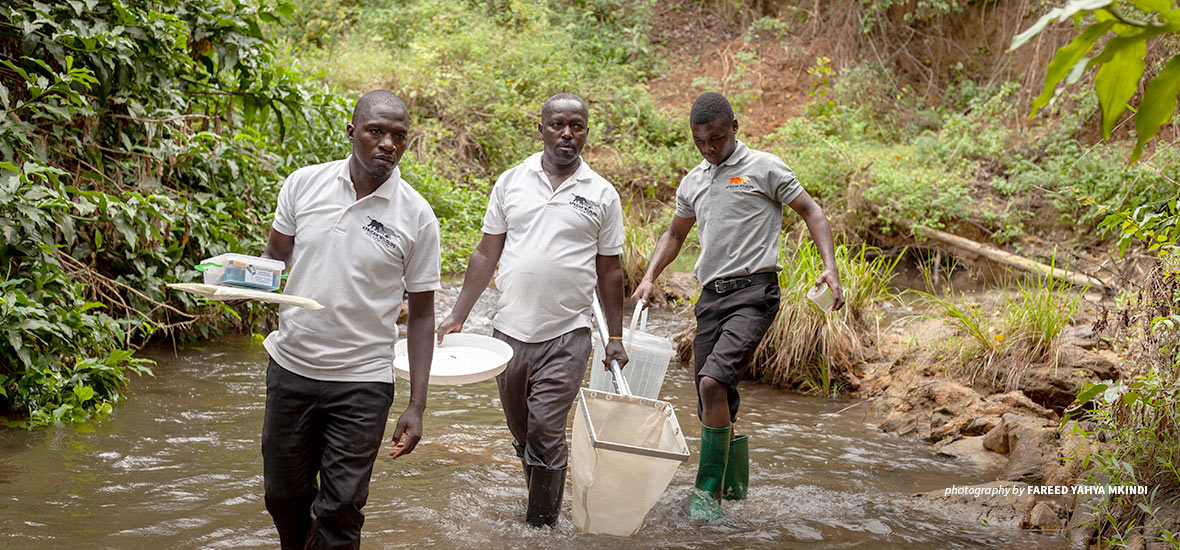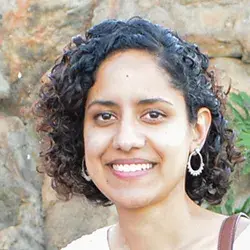Meet AWF’s ecohydrologist working to restore Tanzania’s ecosystems

Antidius Raphael oversees community-based water management interventions in Southern Tanzania's Kilombero landscape
Antidius Raphael, African Wildlife Foundation’s new Ecohydrologist in Kilombero, Southern Tanzania, started his journey with the organization as a student trainee in 2019 while completing an undergraduate degree at the Sokoine University of Agriculture. Following his master’s in environmental and natural resource economics, Antidius returned to AWF as an intern in 2021, assisting landscape restoration and water resources management projects in key catchments in the Kilombero landscape.
In May 2023 — with a second M.Sc. degree in Applied Ecohydrology from a consortium of four European universities under his belt — he returned to AWF once again to implement nature-based solutions in the same landscape under the ‘SUSTAIN - Ecosystem Stewardship to Balance Sustainability and Growth in Tanzania (SUSTAIN Eco)’ program.
As Antidius embarks on this new role, we sit down with him to understand the potential of nature-based solutions to restore degraded ecosystems and sustain livelihoods in the Kilombero Valley — Tanzania’s breadbasket and home to endemic wildlife species in the Udzungwa Mountains National Park.
What is ecohydrology?
The concept of ecohydrology is framed in its name, which merges ‘ecology’ and ‘hydrology.’ The latter covers the protection of water resources and the management of the water system in general, while the former encompasses the entire natural ecosystem. Ecosystems depend on water; if you remove water from the ecosystem, it will collapse. By conserving the water sources, we are conserving the ecosystem. Therefore, ecohydrology explores the interaction between water and ecosystems, and the biological processes underpinning them.
Ecohydrology is thus an interdisciplinary field of study that focuses on understanding the interactions and relationships between ecosystems and the hydrological processes that occur within them. It integrates principles from ecology, hydrology, and other related disciplines to examine how water influences ecosystems and how ecosystems, in turn, impact water availability, quality, quantity, and distribution.
As AWF’s ecohydrologist based in Ifakara, Kilombero District, I help in developing and instituting nature-based solutions that tackle ecosystem problems while addressing challenges of water ecosystems and river health in key river basins in the landscape. I oversee community-based projects that integrate ecology and hydrology, so we can restore degraded ecosystems to sustainably maintain the people’s livelihoods and increase biodiversity to ensure that the ecosystem is well-functioning.
What are the benefits of nature-based solutions?
A degraded river ecosystem is evidenced by eroded riverbanks, siltation, low flow rate, and deteriorating water quality. Installing geotechnical structures (such as gabions, riprap, and bank protection mats) has a significant cost implication for local communities and authorities.
On the other hand, when you restore the riverbanks, you restore the related biodiversity and ecosystem connectivity. Water users benefit from healthier rivers — as the river flow increases, they have more water for irrigation and fishing. The more a community harnesses the ecosystem, the more resilient the ecosystem becomes, which makes the provision of goods and services more reliable.
Additionally, the healthier the river is, the greater the diversity of life it supports. For example, if rivers are degraded in protected areas, wildlife like elephants are more likely to wander into community lands for water and pasture. Likewise, restoring land outside protected areas also helps the land regain its fertility and reduces human intrusion into protected areas. As community lands become more productive, people will not extend to protected and conserved areas to establish farmlands.
How does AWF improve river health in the Kilombero landscape?
One of the first and most important steps of conducting a river assessment is to establish the reference conditions to track the progress of the restoration efforts by measuring the water quality, biodiversity levels, and water flow before the interventions. When I joined AWF as a field student trainee in August 2019 and then as Inclusive Green Growth (IGG) project Intern, we ventured into the restoration work by conducting a baseline study in the degraded upstream areas of the Mngeta and Mchombe Rivers.
Additionally, AWF worked with the Rufiji Basin Water Office to establish Water User Associations (WUAs) in the Mngeta sub-catchment in 2017 and introduced simple, accessible water monitoring tools and methods — known as the Mini Stream Assessment Scoring System (miniSASS) using a Tanzanian Rivers Scoring Systems (TARISSfupi). Since then, WUAs regularly assess their rivers and can make informed decisions about community water and land use. We are yet to conduct a scientific river quality assessment; however through observations and use of introduced water quality monitoring tools we are confident to say there has been improvements in the water quality and quantity.

Antidius Raphael (first from right) with Water User Association representatives during a river assessment exercise
What is the impact of ecosystem restoration in Kilombero?
Some ecosystem restoration efforts may not always have immediately visible impacts on the quality of the environment. Kilombero landscape is a huge area, and our interventions are only limited and intensified to a specific hotspot area. However, indicators and signs of gradually improving ecosystem health point to the existing effort.
Over the last seven years, we have seen an increased interest by local communities to manage water resources, especially rivers in Mngeta and Ruipa where SUSTAIN I intervened in the management of water resources. This has resulted in an increase in the volume of the water flowing through the rivers and an abundance of macroinvertebrates — an important indicator of river health assessment.
Interestingly, the water in the Mchombe River also became clearer. Previous cultivation on the riverbanks had polluted the river due to fertilizer runoff. AWF worked with communities and Village Natural Resources Committees (VNRC), through the relevant WUAs, to demarcate, restore and conserve a 60-meter riparian (buffer) zone from the river where agricultural activities are not allowed. Using Kizimba Business Model in waste disposal management has reduced water pollution through agrochemicals and plastics. Additionally, replanting native tree species has reduced erosion and mitigated siltation downstream while restoring the ecosystem.
What is the importance of working with communities in water catchment areas?
A water catchment is an area of land belonging to either a community or government or an individual where water collects when it rains, often bounded by hills, forest, or springs. As the water flows over the landscape, it finds its way into streams and the soil, eventually feeding the river.
Usually those on the upper stream (on the source) have the potential to affect this process compared to those on the downstream. Since this water is shared amongst the diverse community, including those located away from its sources, it calls for the engagement and collaboration of all stakeholders in managing the entire ecosystem. Local communities in the catchment are potential stakeholders in the management of a water catchment.
The most significant advantage of providing communities with the knowledge and tools to manage natural resources is that they feel a sense of ownership of the resources and therefore, restoration and conservation works related to the resource. This ensures the sustainability of AWF’s interventions beyond the implementation period and allows us to partner with them on future conservation efforts. For example, the water user associations we helped set up are now fully responsible for assessing and restoring their river.
Through the SUSTAIN Eco program launched in May 2023, we are extending this restoration approach to the Vidunda catchment, where three village communities will be engaged in the restoration of catchment forest around water sources, and also a Payments for Ecosystem Scheme will be established as a finance mechanism to promote and enhance conservation initiatives by the local communities. Severe upstream degradation affects users in the middle and lower reaches of the river, including smallholder farmers and the Kilombero Sugar Company, one of Tanzania’s biggest sugar producers.
Restoration plans intend to strengthen the connection between the upstream, the middle, and the downstream users, thereby securing the entire ecosystem. As such, ecosystem goods and services can sustain livelihoods and economic growth. At the same time, wildlife populations benefit from intact ecosystems. It is always a win-win situation when we live in harmony with nature instead of leaving it behind. We are all part of the biosphere, so we must keep working together with nature as the center bolt.
